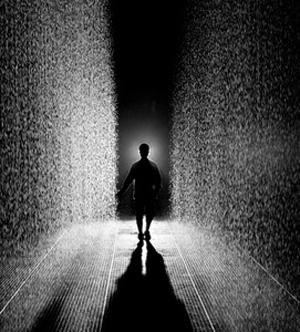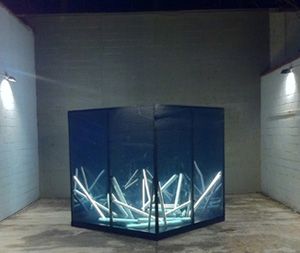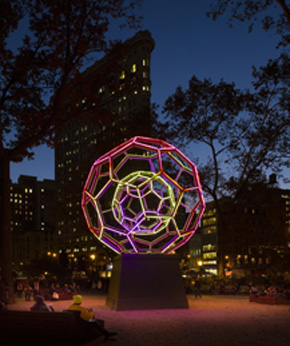Bright Lights, Black City
John Haberin New York City
Rain Room and Other Light Shows
Santiago Taccetti, Laddie John Dill, and Leo Villareal
For a kid, it is hard to beat running through a lawn sprinkler or the shower from a hose in the sun. An adult will just have to settle for Rain Room at the Museum of Modern Art. The differences speak to more than just growing up. They are also about growing into the tawdry spectacle of the art world.
Critics like me may complain, but the spectacle of art is drawing crowds, while getting more and more out of hand. It also takes more and more technical sophistication just to light up the darkness. With Rain Room, Random International takes the outdoors and the light show inside as a disturbingly successful illusion.  Yet two relatively old-fashioned uses of lights and mirrors, in Santiago Taccetti and Laddie John Dill, better explain art's turn to a black box. Sculpture in the parks by Leo Villareal, Sandra Gibson, and Luis Recoder then shows how the theater expands out of doors. They point to the influence of both technology and optics, from Buckminster Fuller to an antecedent of installations and photography—the camera obscura.
Yet two relatively old-fashioned uses of lights and mirrors, in Santiago Taccetti and Laddie John Dill, better explain art's turn to a black box. Sculpture in the parks by Leo Villareal, Sandra Gibson, and Luis Recoder then shows how the theater expands out of doors. They point to the influence of both technology and optics, from Buckminster Fuller to an antecedent of installations and photography—the camera obscura.
Lawn sprinklers: the opera
A lawn sprinkler is cheap, casual, and spontaneous. Anyone can try it—or at least anyone with reasonably tolerant parents and a yard. (New Yorkers like me had fire hydrants in the heat, until the city figured out how to secure them.) Rain Room takes an entire building, a temporary structure on contested museum real estate. It also takes fancy technology, which not just detects but anticipates one's every move. It allows a torrent around one to cease as one walks or scampers in the darkness, but is that truly an improvement?
The first is in daylight, letting a child feel a part of a summer afternoon. Never mind that suburban sprawl is a human construct, with messy consequences. For a child, that is comforting as well. The other boasts of the darkened theater and the illusion, where even an intense spotlight barely picks out others in the rain. It creates the shimmer of an artificial nature, and a viewer strains to see whether ten other people really do escape it. Maybe they are just pretending to be dry, as a matter of pride, and maybe the magic will end if one sticks out one's hand.
The first is incomplete if one does not get thoroughly soaked. The other allows one to resume one's grown-up duties on exit, and it has plenty of signage warning that one might get wet, to cover the museum's behind just in case. (For the record, my sneakers and trouser cuffs were slightly damp.) And the first is instantaneous, while the second takes waiting in line. I waited well over two hours its first weekday morning, before it hit the press and while most New Yorkers were working, and others will risk not getting in at all. At the Barbican in London, where Rain Room ran for nearly a full year, people waited up to twelve hours for the fashionably dark and empty installation—and said that they would do it again.
Would I do it again? No way in hell, but I can see why others would, as blockbusters and big-ticket installations grow closer and closer to Disneyland. This spring, Doug Aitken closed out his gallery's last location with water dripping from the ceiling into a huge hole smashed in the floor. MoMA in fact milks the occasion for money, by asking every few minutes if anyone would like to become a member, cutting right to the front of the line. After an hour or so of boredom and torture, it is an obvious temptation. Maybe the whole event is the work of art, right down to one's credit card.
The line's last ten minutes are part of the work, far and away the best part, as one waits one turn inside. One could be seeing it all on video, and in fact Bill Viola anticipated the empty spectacle by striding into a downpour or into flames. Fried objected to Minimalism on the grounds that the encompassing space distracts from the art, but then Minimalism has some pretty darn solid and unpretentious objects, and Rain Room could have you wishing that they were back. Viola, in contrast, created a postmodern opera—but that was just the 1990s, and Rain Room multiplies his cast by ten. Or maybe it is postmodern dance, because one naturally spreads one's wings as one twists and sways in the rain. Random International, an Anglo-German collection, speaks of its work as "choreographic interventions."
They sure touch a lot of bases between suburban America, new media, performance, interactive art, theater, opera, dance, and sheer exploitation. They also work between art and science, and Rain Room is a "module" in "Expo 1: New York," a larger show about ecosystems spanning three boroughs. So many bases may testify to the installation's fabulous scope or to a failure to mean much of anything at all. What exactly does it say about nature, other than that this particular rain forest has lost its trees? I felt annoyed, impressed, and seriously exploited, but I am still haunted by one moment on the way out. As people exited off to the right at the far end, light through the open door reminded me of the room in Las Meninas, by Diego Velázquez—with its own strange illusion of a passing moment—and maybe elsewhere, in a better work of environmental art, that moment will come again.
Mirroring the darkness
A black box. People in glass houses. Santiago Taccetti's Smoke and Mirrors / Nothing to See Here embraces metaphors, but in perhaps art's least metaphorical tradition ever. His black cube, just slightly larger than life (oops, another metaphor), has a color, geometry, and materials entirely at home (oh, no) in Minimalism. Its glass leaves its regular supporting lattice quite clear. Its shape, translucency, and glow from within quote Carl Andre. Its only addition, ordinary fluorescent tubes, quotes Dan Flavin and then some.
Its timing could hardly be better, just when any number of painters and photographers are engaging geometric abstraction. In the process, they are also changing its terms, since riffing on it means dismantling it. With Taccetti, Flavin's white tubes have fallen to the ground and pierced the walls. They break Andre's closure, for one can enter the geometric confusion of reflections and refractions off dark glass. Yet they end up taking Minimalism that much further. They surrender Flavin to gravity, and they make Andre's colored boxes a black stage set for Minimalism's theater.
 Michael Fried complained about that "theatricality," notoriously so, but that was a long time ago. People have lined up for a long time now, to experience Rain Room, Anthony McCall or the twinkling enclosures of Yayoi Kusama, in what the Whitney once declared art's "summer of love." Taccetti updates Kusama for the realities of Brooklyn loft conversions. His paintings, flanking a box in the backyard, stick largely to black, too, in a formless ooze that recalls Jules Olitski and Rebecca Purdum. At least the polyurethane and resin have the decency to look thoroughly disgusting. Marks outside the borders of some panels serve as evidence, like leftovers from the Newtown Creek Superfund site.
Michael Fried complained about that "theatricality," notoriously so, but that was a long time ago. People have lined up for a long time now, to experience Rain Room, Anthony McCall or the twinkling enclosures of Yayoi Kusama, in what the Whitney once declared art's "summer of love." Taccetti updates Kusama for the realities of Brooklyn loft conversions. His paintings, flanking a box in the backyard, stick largely to black, too, in a formless ooze that recalls Jules Olitski and Rebecca Purdum. At least the polyurethane and resin have the decency to look thoroughly disgusting. Marks outside the borders of some panels serve as evidence, like leftovers from the Newtown Creek Superfund site.
Also in Brooklyn, Carol Salmanson's small strings of LEDs spell out mildly decorative messages in nonexistent alphabets. Perhaps they, too, riff on Flavin, along with neon words and Christmas lights. I like better her drawings, akin to the denser mysteries of Cubism. They also bring out the nature of her strings of lights, as simultaneously drawing in space and flowing with current. A series of works in lights even bears the title Gesture Drawing, while a series on paper is Calligraphic Transmissions. She need never say that her name is in lights.
Even California's fabled Light and Space movement of the 1960s felt the temptation of the darkness. Laddie John Dill began his west-coast parallel to Minimalism in 1969, with tubing colored by the glass and the elements. These Light Sentences may seem familiar enough from Flavin, Keith Sonnier, and their fluorescence. And Dill's mirrors in sand could come right out of a textbook—for a chapter devoted to Robert Smithson. How strange to discover that he has been a part of contemporary art for almost as long as they (with credit as ever to Nyehaus for its championing of a place and time). Stranger still is to see his ghostly radiance and its place in the present.
Where Flavin mediates between natural light and industrial processes, Dill's tubes lit by the noble gases within anticipate LEDs. And where Smithson mediates between natural environments and their displacement, Dill's mirrors reflect the gallery light almost as plainly as Robert Irwin. Make that low light. On the scale of shelves and tables, they look like an ongoing science project devoted to light and color. Rather than call attention to their environment or escape the confines of the art scene, they reshape it and illuminate it. Once again, the viewer has entered a black box.
Festival of lights
Much of the pleasure in Leo Villareal's BUCKYBALL comes in seeing whether you guessed right. Would it glow with a single color, and which one? Would it be a cool fluorescence or something more painterly and fiery? Would the brightness flow through the surface, like liquid light, or vanish in an instant? Or would each of two enormous buckyballs have its own hue and intensity, outlining once and for all their nested shapes? Could they be red and green, please, for the holidays?
Probably not, boys and girls, but wait a few moments, for the changes come fast. Villareal built the iconic geometry from nearly two hundred LED tubes, and acolytes of Buckminster Fuller could do a back of the envelope calculation to predict exactly how many. (Well, okay, one-hundred eighty.) After that, math will take one only so far, for patterns and pulses appear entirely at random. At thirty feet tall, the latest sculpture in Madison Square Park offers plenty of possibilities, so one may as well settle into one of the surrounding "zero-gravity couches," whatever that means, and enjoy the show. There really is not that much more to it, and fine.
Maybe there would not be that much more to Fuller either without his perseverance and idealism, the kind that drew him to Isamu Noguchi—but that is also part of why he is relevant to a more tarnished age. Still, I would not expect too much, beyond some serious fun. The pixels can produce any of sixteen million colors, at least in theory, and a basis in technology rather than Minimalism and landscape makes an intriguing contrast with Dan Flavin (or the park), but it is still a light show. While the sculpture settled into place in warmer weather, before the holiday lights across Shake Shack, it could be ticking off shopping days till Christmas. Still, it sure beats an actual Happy Holidays in lights at the Fifth Avenue corner. The oversized script letters (upside down, at that) feel downright threatening, and the white panel behind them lands like a concrete block. 
Art in the park has a decidedly mixed track record, maybe because it tries so hard to please. The Madison Square Park Conservancy seems to want it less to accommodate the park's topography and traffic than to attract families and tourists. In the park's next redefinition of site-specific art as science experiment after Villareal, Sandra Gibson and Luis Recoder allow a welcome degree of solitude. Some may mistake their white cylinder for a public toilet or a construction site, and most seem to pass it by. Those who linger will find space for just one or two, shared with a park ranger waiting inside. First, though, one has to knock.
Gibson and Recoder do defer to their surroundings, although only as an image. Their enclosure serves as a camera obscura, for a ghostly panorama projected by nature alone. Light through a pinhole on the south side does nature's handiwork, which changes with the time of day—although with admission only before 5:00 sharp. The blurry silhouettes have the charm of an old photograph, only larger. Yes, that dark tower pointing down is the Flatiron Building, and trees spread out along the floor. The path of light has no choice but to project them upside-down.
The scale adds interest to an obvious formula, separating the experience from a jpg online. So does a surprise I ought to have anticipated: the image moves. The apparent rapid passage of a bright circle across the wall is not the peephole in motion, but reflection off passing cars, and the dark pedestrians at top that appear right-side up are their shadows on the sidewalk. Topsy Turvy is fun to enter, especially when it rights itself, but this experiment in art and optics still feels like a leftover from any number of science fairs, and it looks from the outside like a cross between a bunker and one of those dreadful cylindrical paper lamp shades. Happy holidays.

"Rain Room" by Random International (on its own Web site spelled rAndom International) ran at The Museum of Modern Art through July 28, officially as part of "Expo 1: New York" based at MoMA PS1 through September 2. Santiago Taccetti ran at Black & White and Carol Salmanson at Storefront Bushwick, both through May 20, 2012. Laddie John Dill ran at Nyehaus through July 26, 2013, Leo Villareal in Madison Square Park through February 28, and Sandra Gibson and Luis Recoder in the park through April 6. I turn to "Expo 1: New York" in a separate review.




